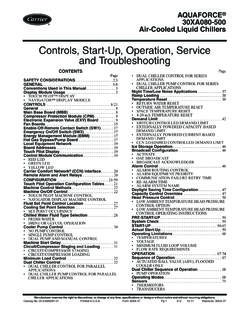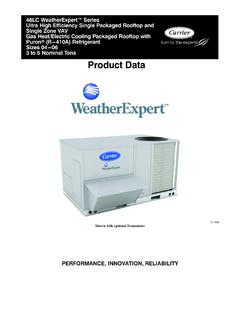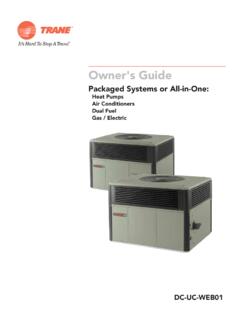Transcription of Water Soure Heat Pumps - Sigler Commercial
1 Water Source heat PumpSystemsCOMMERCIAL HVAC SYSTEMS Technical Development Program Technical Development Programs (TDP) are modules of technical training on HVAC theory, system design, equipment selection and application topics. They are targeted at engineers and designers who wish to develop their knowledge in this field to effectively design, specify, sell or apply HVAC equipment in Commercial applications. Although TDP topics have been developed as stand-alone modules, there are logical groupings of topics.
2 The modules within each group begin at an introductory level and progress to advanced levels. The breadth of this offering allows for customization into a complete HVAC curriculum from a complete HVAC design course at an introductory-level or to an advanced-level design course. Advanced-level modules assume prerequisite knowledge and do not review basic concepts. This TDP module will provide an understanding of the components in Water source heat pump systems, configuration options, system benefits, and many applications associated with the overall system.
3 WSHP systems have become a very popular choice for use in Commercial buildings where individual zones of control are required to maintain comfort conditions. Building types that exhibit a simultaneous cooling and heating load are ideal candidates. WSHP systems have other desirable characteristics like zoning capability, ease of design, and reliability so that buildings where little or no reclaim will take place are often still considered for using a WSHP system. 2006 Carrier Corporation. All rights reserved.
4 The information in this manual is offered as a general guide for the use of industry and consulting engineers in designing systems. Judgment is required for application of this information to specific installations and design applications. Carrier is not responsible for any uses made of this information and assumes no responsibility for the performance or desirability of any resulting system design. The information in this publication is subject to change without notice. No part of this publication may be reproduced or transmitted in any form or by any means, electronic or mechanical, for any purpose, without the express written permission of Carrier Corporation.
5 Printed in Syracuse, NY CARRIER CORPORATION Carrier Parkway Syracuse, NY 13221, Table of Contents 1 Water Source heat Pump Unit 2 Cooling Mode .. 3 Heating Mode .. 3 Mode 4 WSHP System 4 Cooling Mode (Summer Operation) .. 5 Heating Mode (Winter Operation) .. 6 Intermediate Season (Spring and Fall Operation).. 7 System Advantages and 7 System 8 System Disadvantages .. 12 Product Overview ..14 WSHP Components .. 14 Compressor .. 14 Reversing Refrigerant-to- Water heat Exchanger .. 15 Expansion Metering 16 Refrigerant-to-Air heat 17 Fan Assembly.
6 17 Condensate Filters ..18 Unit 18 Hydronic Accessories .. 20 WSHP Unit Types ..22 Horizontal 23 Vertical Console Stack Units ..25 Rooftop 26 Water -to- Water heat Pump 27 System Overview .. 28 Components .. 28 Cooling Tower .. 28 Boiler ( heat Adder) .. 30 Air Distribution System .. 32 Ventilation Air Distribution Water 33 Air Separator and Expansion 33 34 Example System 34 Single-Story 35 Two to Four-Story Buildings .. 35 High-Rise Buildings .. 36 System Variations .. 36 Variable Volume and Temperature (VVT ) System .. 36 VAV in the Interior Variable Flow Hot Water 38 Sprinkler Piping Integrated with the WSHP 38 System Without a Boiler.
7 39 System With a Storage 39 System Application Topics .. 41 WSHP Units With Freeze Protection ..41 Antifreeze 43 Water Ventilation System Energy Recovery .. 45 System IAQ Topics .. 48 Acoustics 52 53 Airside Water -Regulating Valves ..54 Maintenance .. 54 Geothermal Systems .. 55 Closed-Loop Systems .. 56 Open-Loop Ground Water Systems .. 59 Geothermal System Advantages .. 60 Codes and Standards .. 61 Performance Related Codes and 61 Safety Related Codes and UL/CSA and ETL .. 64 System Sizing and Layout Tips .. 64 WSHP Cooling Tower Selection.
8 66 Boiler ( heat Adder) ..67 Ventilation 68 Piping 71 73 Air Separator and Expansion 74 74 WSHP Thermostats and Controllers .. 75 Water Sensors and Switches .. 77 Pump Control .. 77 Cooling Tower and 77 Ventilation 78 System Safety and Alarms .. 78 Reducing Operating 79 Overall System 79 Summary ..81 Work Session .. 82 Work Session 89 Appendix A Water Quality .. 90 Water SOURCE heat PUMP SYSTEMS Commercial HVAC Systems 1 Introduction Water source heat pump (WSHP) systems have become a popular choice for Commercial buildings where multiple zones of control are desired.
9 They can also be applied successfully in smaller installations like residences. This TDP module will discuss both applications, but will concentrate on the Commercial applications. The usage of WSHP systems breaks down to roughly 60 percent new construction and 40 percent retrofit and replacement. In this TDP module, we will learn about the various types of Water source heat pump units that can be used to comprise a HVAC system. The internal components in a typical WSHP unit and the function of each will be explained.
10 This will allow the reader to understand how the WSHP units operate when connected to a system Water loop. System components will be then discussed. These include boilers, towers, Pumps , piping, and controls. See Figure 1. There are many overall variations for WSHP systems. They may be categorized into two main groups. The first system type is a standard closed-loop system where the loop piping runs inside the building. This system typically includes a boiler (also called a heat adder), a cooling tower (also called a heat rejecter), Pumps , and controls as shown in Figure 1.










